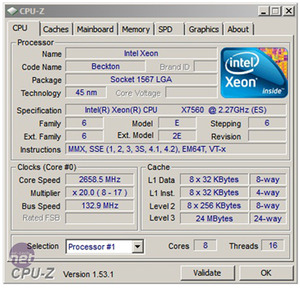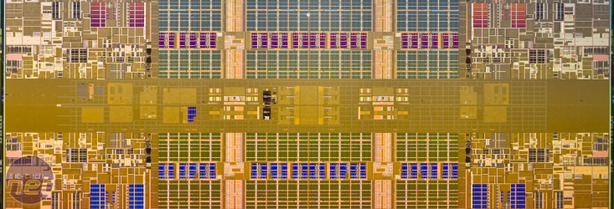Up Close: Intel Xeon X7500-series
Unlike the recently launched Xeon 5600-series, which is intended for use in dual-processor workstations and servers, the Xeon 7500-series is intended for use in high-end servers, such as those found in data centres and financial institutions.For these sorts of users, the number of execution units and manageability/reliability of a server are far more important than the individual performance of each core. That said, moving from the ageing Core 2 architecture to the Nehalem EX architecture, each core in a Xeon 7500-series CPU performs much better than a core in a Xeon 7400-series CPU.
As Nehalem EX is the seventh revision of the Nehalem architecture we won’t go into much detail about it here, but if by some stretch of the imagination you’ve forgotten what makes Nehalem special then you can read about it here.
What’s important to note is that the first Nehalem EX CPUs, codename Beckton, have eight physical cores plus eight logical Hyper-Threaded cores. Nehalem EX has a similar cache architecture to other Nehalem CPUs, sticking with the same 32KB instruction and 32KB data cache and 256KB cache per core of its other Nehalem chips. However, Nehalem EX does have a, proportionally, far larger shared Level 3 cache, 24MB to be precise – 33 per cent more per core than other Nehalem CPUs.
At launch, Intel is announcing eight different models in the Xeon 7500-series, but for this review we’ll be focussing our attention on the flagship X7560 model, which is clocked at 2.26GHz and has a cool list price of $3,692. The table at the bottom of this page summarises the principle differences between the different models. However, it's worth remembering that like all Nehalem CPUs, Nehalem EX supports Turbo-Boost so the chips can automatically overclock themselves by a few hundred megahertz when not running at maximum TDP.
Nehalem EX also
 has a different memory controller to other Nehalem CPUs, most of which support either dual- or triple-channel DDR3. Instead, Nehalem EX has a quad-channel controller that can support up to 1,066MHz registered ECC DDR3, delivering far greater memory bandwidth than the dual-channel 667MHz DDR2 controller used in the Xeon 7400-series.
has a different memory controller to other Nehalem CPUs, most of which support either dual- or triple-channel DDR3. Instead, Nehalem EX has a quad-channel controller that can support up to 1,066MHz registered ECC DDR3, delivering far greater memory bandwidth than the dual-channel 667MHz DDR2 controller used in the Xeon 7400-series.What’s more, unlike the Xeon 7400-series, which had to use costly and hot-running FB-DIMMs, the Xeon 7500-series can use standard off-the-shelf registered ECC DIMMs. This is made possible by moving the AMB (Advanced Memory Buffer) from the DIMMs to the motherboard. This makes the individual DIMMs much cheaper to produce and significantly reduces their operating temperature. Theoretically, this means a quad-socket Xeon 7500-series motherboard can support up to 1TB of RAM, a fourfold increase over the Xeon 7400-series.
While Intel has been good about allowing end-users to easily upgrade from the Xeon 5500-series to the Xeon 5600-series, thanks to its eight physical cores and quad-channel memory controller Xeon 7500-series CPUs are really quite large processors. Thus, Intel had to develop a new packaging format, LGA1567.

A close-up of the 8-core Beckton die at the heart of the Xeon 7500-series. Click to enlarge.
The only odd thing about the Beckton core is that unlike the other recent additions to the Nehalem family, such as the Core i7-980X Extreme Edition, which are made using 32nm transistors, it’s made using its previous generation 45nm manufacturing process. Presumably this is because Intel wants to reserve its comparatively limited 32nm manufacturing capacity for higher-volume CPUs such as the Xeon 5600-series. After all, regardless how good Beckton turns out to be, as a high-end server CPU it’s not going to sell in huge numbers.
| Model | Frequency | Physical cores | Logical cores | TDP | DDR3 support | List Price |
| X7560 | 2.26GHz | 8 | 8 | 130W | 1,066, 800 | $3,692 |
| X7550 | 2GHz | 8 | 8 | 130W | 1,066, 800 | $2,729 |
| X7542 | 2.66GHz | 6 | 0 * | 130W | 1,066, 800 | $1,980 |
| L7555 | 1.86GHz | 8 | 8 | 95W | 1,066, 800 | $3,175 |
| L7545 | 1.86GHz | 6 | 6 | 95W | 1,066, 800 | $2,087 |
| E7540 | 2GHz | 6 | 6 | 105W | 1,066, 800 | $1,980 |
| E7530 | 1.86GHz | 6 | 6 | 105W | 1,066, 800 | $1,391 |
| E7520 | 1.86GHz | 4 | 4 | 95W | 1,066, 800 | $856 |
* = Please note, the X7542 does not support Hyper-Threading, so has six physical cores, but no additional logical cores.

MSI MPG Velox 100R Chassis Review
October 14 2021 | 15:04









Want to comment? Please log in.